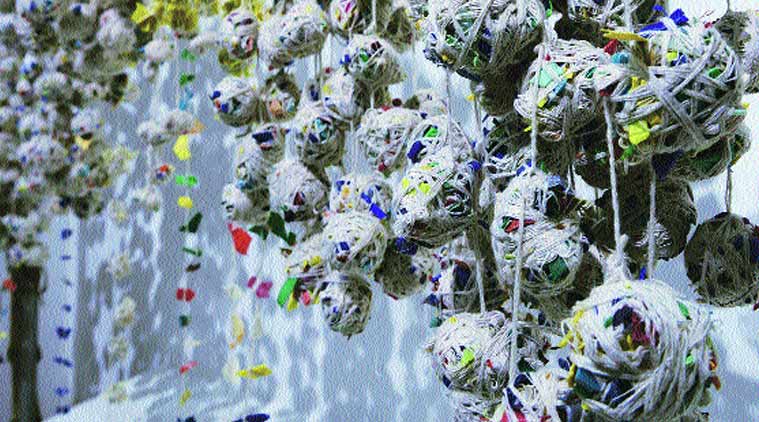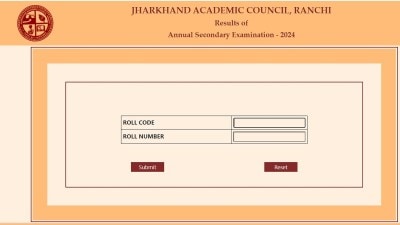- India
- International
Apocalypse Again
Four contemporary artists discuss past, present and future conflicts of the human race.
 Mumbai-based artist Prajakta Palav Aher’s installation shows plastic garlands.
Mumbai-based artist Prajakta Palav Aher’s installation shows plastic garlands.
Threatening bird diseases, genetically modified babies and the problem of plastic waste become the focal points for four contemporary artists as they discuss past, present and future conflicts of the human race
A woman impeccably dressed in black evening wear enters an enclosure that resembles a laboratory. Tucking her hair carefully into a shower cap, she puts on safety glasses and industrial rubber gloves. A knife in hand, she picks up one of the eight pillows that are placed in the enclosure and begins to attack it mercilessly, tearing at the cover and pulling out the feathers. This goes on for about 20 minutes until the enclosure is full of bird feathers from the slaughtered pillows.
This performance, titled Screaming Feathers, by Berlin-based artist Nezaket Ekici, was conceived after the 2003-04 bird flu outbreak. Deeply disturbed by the abuse of poultry during this period, she reacted in protest. “Through my performance, I’m responding to the ill-treatment of birds by humans,” she says, adding, “The sound of the screaming hen in the background, the feathers that swirl around and my violent attack create a sense of discomfort and open the viewer’s eyes to the torture we are inflicting upon a species.”
Ekici’s performance opened the show, titled “Dissonance: Transgressed boundaries between Desire and Fear”, recently at the Percept Art Gallery in Mumbai. “The concept was to highlight the problems the human race has brought upon itself. We invited artists to react to global issues of, say, living under the constant threat of ecological crises, the power of consumerism in our lives, the overflow of data on social media and the desire to manufacture perfection in everything from crops to babies through genetic modification,” says Jesal Thacker of the gallery, who has curated the show along with Vienna-based curator Isin Onol.
While Ekici targets animal healthcare, her contemporaries — Berlin-based Pinar Yoldas and Vienna-based Nita Tandon — contextualise their works in a more futuristic space. Yoldas’ works, “Design Babies”, take the form of small eerie sculptures of human fetuses that are encased in glass jars. The fetuses are adorned with colourful beads and hair extensions and represent the idea of extreme modification to fit idea of beauty. Interested in neuroscience and bio-ethics, Yoldas says, “My work questions the limits to which human beings will alter the human biology, going against the course of nature till they realise what they have done.” Tandon imagines a similar dystopian society, through her work Fingerprint Erased. Through a performance video, we see her physically scrape acyclic paint off a wall, signifying the need to erase digital fingerprints, being left behind with every new technology we embrace.

Closer home, Mumbai-based Prajakta Palav Aher’s work is the result of a year-long project based on the issue of plastic waste. She presents “plastic garlands” — plastic scraps tied together with white thread. “When I began, I understood that the labour class chasing the basic dream of roti, kapda and makaan had little time to worry about waste and environment. So I thought of explaining it to them in a way they could relate with,” Aher says. For a year, she would lug along a bag filling it with plastic bottles, wrappers, bags and toys from the streets. Then she would seat herself roadside and begin to make a mala out of the scrap. “People recognise mala-making. They’ve seen their mothers and grandmothers tie threads around fresh flowers to make a garland,” says Aher. This familiarity of ritual would draw them in, and she’d invite them to join her, starting a conversation about plastic and waste. Having a dialogue was essential, she says. “Hawa and paani are not the only things that are polluted. Talking helps people understand the urgency of this impending disaster,” she says.
Apr 19: Latest News
- 01
- 02
- 03
- 04
- 05






































